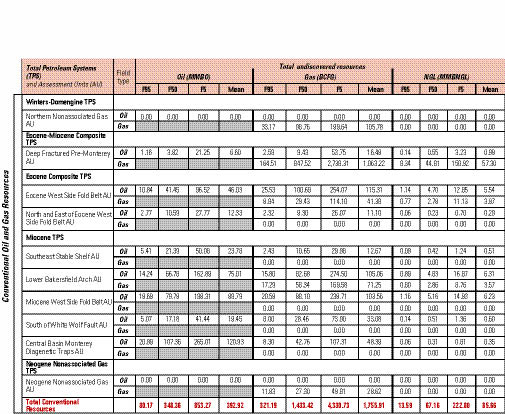U.S. Department of the Interior
U.S. Geological Survey
Fact Sheet 2004-3043
April 2004
Using a geology-based assessment methodology, the U.S. Geological Survey estimated a mean of 1.7 trillion cubic feet of undiscovered natural gas, a mean of 393 million barrels of undiscovered oil, and a mean of 86 million barrels of natural gas liquids in the San Joaquin Basin Province.
The U.S. Geological Survey (USGS) recently completed an assessment of the undiscovered oil and gas potential of the San Joaquin Basin Province of California (fig. 1). The assessment is based on the geologic elements of each total petroleum system defined in the province, including hydrocarbon source rocks (source-rock type and maturation, and hydrocarbon generation and migration), reservoir rocks (sequence stratigraphy and petrophysical properties), and hydrocarbon traps (trap formation and timing). Using this geologic framework, the USGS defined 5 total petroleum systems and 10 assessment units within these systems. Undiscovered oil and gas resources were quantitatively estimated for the 10 assessment units (table 1).
_opt.jpg)
With respect to undiscovered conventional hydrocarbon resources in the San Joaquin Basin Province, the USGS estimated means of 1.7 trillion cubic feet of gas (TCFG), 393 million barrels of oil (MMBO), and 86 million barrels of total natural gas liquids (MMBNGL) for the five total petroleum systems (exclusive of reserve growth in existing oil and gas fields). Well over half of both the mean undiscovered gas resource (62 percent, 1 TCFG) and the mean NGL resource (67 percent, or 57 MMBNGL) is in the Deep Fractured Pre-Monterey Assessment Unit of the Eocene-Miocene Composite Total Petroleum System (table 1). Of the mean 393 MMB of total undiscovered oil, about 328 MMBO (83 percent) is estimated to be in five assessment units of the Miocene Total Petroleum System, and 46 MMBO (12 percent) is estimated for the Eocene West Side Fold Belt Assessment Unit of the Eocene Composite Total Petroleum System (table 1). Nearly 31 percent, or 121 MMB, of the total mean undiscovered oil resource in the San Joaquin Basin Province is estimated to be in the Central Basin Monterey Diagenetic Traps Assessment Unit.
Potential reserve growth in existing oil and gas fields in the San Joaquin Basin Province was calculated during our study. Based on the analyses of recovery efficiencies and remaining oil-in-place, we estimated that another 3.5 billion barrels of oil may be added to reserves in existing fields. Most additional reserves may come from improved recovery in diatomite reservoirs of the Miocene Monterey Formation. This estimate of potential reserve growth suggests that most oil in the future may come from existing fields rather than from new oil field discoveries in the San Joaquin Basin.
 (click on image for larger version)
(click on image for larger version)
Supporting geologic studies of total petroleum systems, assessment units, reserve growth, and the methodology used in the San Joaquin Basin Province assessment are in progress. Assessment results are available at the USGS Central Energy Team website, http://energy.cr.usgs.gov/oilgas/noga.
Donald L. Gautier (Task Leader; gautier@usgs.gov), Allegra Hosford Scheirer, Marilyn E. Tennyson, Kenneth E. Peters, Leslie B. Magoon, Paul G. Lillis, Ronald R. Charpentier, Troy A. Cook, Christopher D. French, Timothy R. Klett, Richard M. Pollastro, and Christopher J. Schenk.
Document Accessibility: Adobe Systems Incorporated has information about PDFs and the visually impaired. This information provides tools to help make PDF files accessible. These tools convert Adobe PDF documents into HTML or ASCII text, which then can be read by a number of common screen-reading programs that synthesize text as audible speech. In addition, an accessible version of Acrobat Reader 6.0, which contains support for screen readers, is available. These tools and the accessible reader may be obtained free from Adobe at Adobe Access.
| AccessibilityFOIAPrivacyPolicies and Notices | |
| |
|